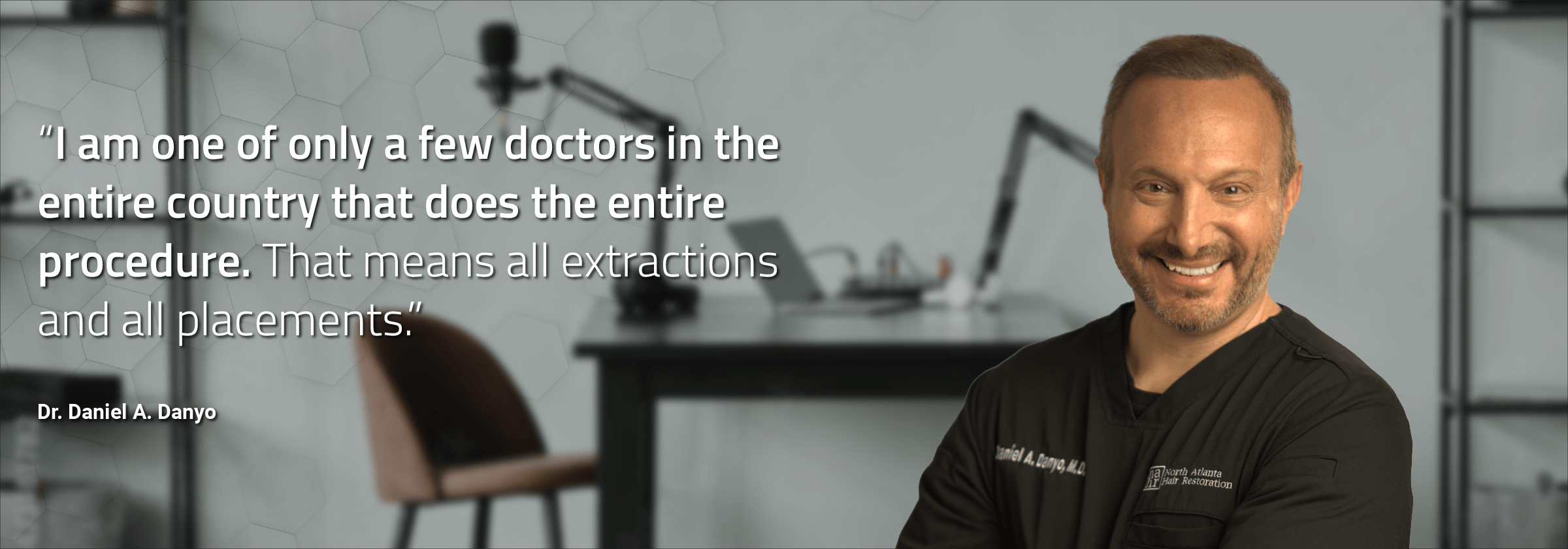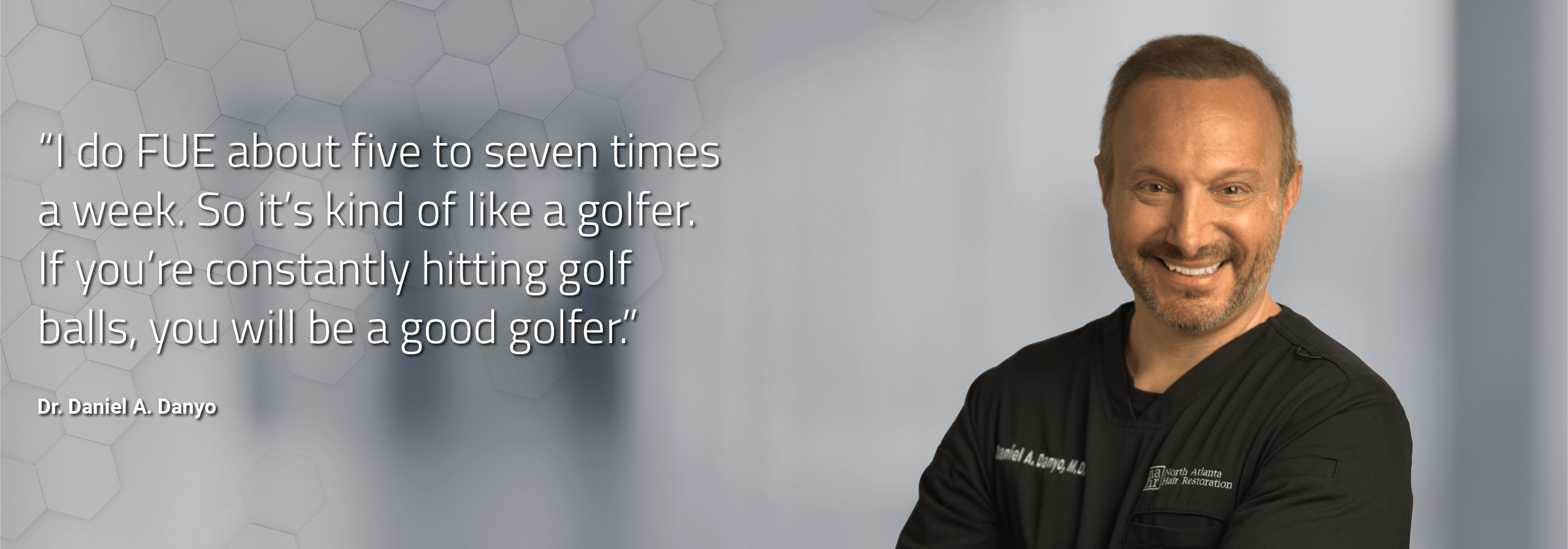The following is a transcript of Episode 4 of the Hair Restoration With Dr. Daniel A. Danyo podcast.
All episodes of the podcast can be found at Apple Podcasts, Google Podcast, and Spotify.
Dr. Danyo: I think the path of least resistance really does not work. If you’re a physician listening to this podcast, to say, “I wanna get into this FUE thing to make and generate more revenue for my practice,” and especially if you’re thinking of relying on techs, I would caution against that.
Clark: That was the voice of Daniel. A. Danyo, MD, Founder and Physician at North Atlanta Hair Restoration, a boutique medical practice solely dedicated to the diagnosis and treatment of male and female hair loss. You’re listening to Hair Restoration with Dr. Daniel A. Danyo. I’m your host Clark, and all season long we’ll be speaking with Dr. Daniel, about how he and his team at North Atlanta Hair Restoration are helping his patients transform their everyday lives for the better. In this episode, Dr. Daniel breaks down some of the misconceptions that physicians often have about hair transplantation. He encourages them to commit to hair transplantation as a specialized field, not a one size fits all procedure. He also empowers potential patients to make informed decisions about who they trust with their hair treatment. Now, let’s jump in. Dr. Daniel, it’s good to be talking to you again.
Dr. Danyo: Hey, Clark, how are you?
Clark: I’m doing great. We’ve got a fantastic topic lined up. It’s a really important one, and it’s basically asking the question why physicians aren’t more involved with hair transplants? And this is something that we’ve seen as a challenge over the years. And quite frankly, it’s a big red flag. And so I’m really hoping to unpack a lot of these key elements with you to hear from your perspective, why you think some physicians just aren’t as involved and what that means.

Dr. Danyo: Sounds great. Well, it’s something that’s true to my heart and true to my endeavors in this field. I am one of actually a few doctors in the entire country that does the entire procedure. That means, like all extractions and all placements, so it kind of raises a question in my mind and in a lot of my patients mind, what exactly are other doctors doing? And that’s kind of what we need to kind of peel apart today and address.
Clark: Right. Well, let’s start off with the first item you wanna address. What’s one of the first things that come to mind when you think about why some physicians just aren’t as involved? Or why they are not more involved?
Dr. Danyo: Yeah, I think the biggest thing, I mean, physicians, they’re constantly expanding on their knowledge and their potential as far as what they can deliver to their patients. So it’s not uncommon for doctors to take courses and learn new procedures and have more things for their patients. Now when it comes to hair transplantation in particular, you can take a weekend course and learn some of the basics about hair transplant, but it really addresses something that I think is vital that this is not a procedure. This is actually a field of medicine and it actually has a board certification tied to it.
Clark: That’s such a good point. So what I’m hearing from you is physicians treat hair transplantation, some of them are treating this just as a procedure, just like another item on a menu.
Dr. Danyo: Exactly, it would be like, I mean, you could take a course say in liposuction and learn pretty much the basics and be somewhat proficient at it, obviously, would take practice. Hair transplant’s different because there are diseases associated with hair loss. There are different conditions even both medically, dermatologically there’s a whole host of other issues that need to be learned and mastered as a physician going into really each consult and into each procedure.
Clark: Dr. Daniel, I wanna ask you something. You just mentioned the certification, how you have board certified credentials, to be able to do this. And I wanna look at this from another perspective from perhaps the device makers who are creating these and how they’re trying to maybe target, some folks out there who they might have the certification, but they don’t have the experience. How have you seen this play a role in this challenge?
Dr. Danyo: Well, doctors have conferences, we have to take continuing medical education. So it’s frequently that we go to different cities and go to these shows and their vendors there. So the manufacturers for hair transplantation, or pretty much at all of the hair transplantation and hair restoration forums and lectures. But they’re also at different academies, say the Academy of Plastic Surgery, or Academy of Dermatology, things like that, where they’re introducing the potential concept of doing hair transplantation in their office. So, there’s a lot of sales associated with looking at this nice gleaming machine and saying you could make this much money per graft, and you could generate this much revenue for your practice and expand your cosmetic business. So, kind of a light bulb goes off with the physicians, and they’re sort of thinking, “Wow, I could purchase this machine at this price. And I could pay this off in about 10 to 15 patients. Wow, this sounds like a great thing.” The problem is they literally buy these machines, sometimes $100,000 to even up to $350,000. Not to mention all the expenditures associated with the machines and blindly go into another field of medicine as if they’re able to market their skills and market this machine to success. And it’s a huge problem. I’ve seen a lot of patients that have had very bad results, very disappointing where their donor site has been depleted greatly, and they’ve had really poor growth. And unfortunately, I don’t think the doctors have bad intentions, but they are not educated in really taking this to the level that is required to have great grafts on every patient and really deliver on your promise of giving them hair.
Clark: Well, you really can’t master anything in a weekend?
Dr. Danyo: No, no. I look at hair transplant really, because I do FUE, which is follicular unit excision hair transplantation, about five to seven times cases a week. So it’s kind of like a golfer. If you’re constantly hitting golf balls, you should be a good golfer. And if you’re playing golf, and you’re in different, like windy conditions and rainy, and hilly, or flat, you can master different conditions to really have a good score. And that’s pretty much what hair transplantation is. Every patient you go in blind, patients have different levels of bleeding, pain control, hair type, tissue type, and it takes a lot of practice to deliver for everybody. And my standards are every graft needs to be delivered in a perfect fashion, both on the extraction and on the implantation side.
Clark: So with some of these devices, are they targeting the physicians to be the ones who are running all of this? How did the technicians sometimes play a role? I know with you, we’ve talked about this in the past you from start to finish are working with the patient, but in some cases, in most cases, that is not the way it is for other practices.
Dr. Danyo: Yes, the device manufacturers, as I said before, are targeting inexperienced physicians. And then they’re purchasing kind of the most expensive machines and often relying on technicians to actually use the machines. You know, they’ll even meet with the patient or with the physicians and say, “Hey, our technicians do this every day. They’re terrific. We can fly them in from different states. You just have to call and we’ll get it all scheduled with your patients, we’ll make it as easy as possible.” So the doctors are really kind of enticed into this fallacy that they can consistently deliver high quality grafts and high quality results with people just technicians coming in and out of the office. And the problem is you don’t know who you’re gonna get. And these technicians oftentimes are not even licensed, and in many states it’s actually illegal for them to administer Lidocaine, actually extract human tissue which a graft is. And there have been and its growing multiple lawsuits where doctors said that they were involved, but they actually weren’t. And it’s a real issue.
The other issue is that just having a machine. And let’s say it’s $100,000 to $350,000. Similar to buying a Ferrari, just because you have a Ferrari doesn’t make you a great driver. And just because you have this machine doesn’t mean that you’re a great physician doing hair restoration, but they market to the machine instead of the actual physician. And then the physicians aren’t involved and it really puts them at risk, massive risk allowing essentially unlicensed care deliverers or technicians doing these procedures, oftentimes in an unsupervised fashion.
Clark: I would imagine a lot of these technicians there’s turnover, who knows how new on the job they are, it’s kind of terrifying. It’s already such an intimate topic and procedure. That’s pretty scary.
Dr. Danyo: No, it is terrifying. And, again, I go back to the physicians that have these types of practices. It is an incredible risk and it’s really obscene that somebody could pay the amount of money that is required to do sometimes even small and large cases, and then to the difficulty in actually implementing the procedure and doing it right. But just allowing somebody to come into the office and say, “I can use this machine.” And giving them the authority to do this procedure. It’s not good. So my advice really for patients is they need to, when they do a consultation, literally have specifics as far as how involved the physician is and how involved the technicians are and where they’re coming from, and what their expertise is. This all needs to be digested and really consumed as a consumer, because you need to make a choice. And I would also recommend getting multiple consultations to do that.
Clark: Right, I’m definitely gonna wanna circle back to that bottom line you’ve just talked about of asking that question, looking, when you’re exploring options as a potential patient asking that question. So let’s continue on this is really helpful information to hear. Now, when you think about physician let’s say, some physicians who’ve been doing this for a while, that method that they were using in the past, times have changed. And I know you specialize with FUE and that might not be a technique that they know or been trained in like you have and how you used that example earlier like golfing. If you’re doing this consistently all the time, you’re just gonna continue staying as sharp as possible. So, have you seen that play a role with how physicians just their experiences, physicians are not created equal with the opportunities that they’ve had for modern techniques for hair restoration.
Dr. Danyo: Exactly. So, I mean, there are many physicians that were trained with doing just the strip and or, FUT which is follicular unit transplant and they got interested in FUE more out of necessity because patients were requesting it and they were requesting it because they just did not want a linear scar in the back of their head. And it’s obviously go to courses and talk to other doctors. I mean, FUE is becoming the primary hair transplant procedure. Although they’re both very common in their scope, but many of the older physicians are not interested in FUE because of the actual time and intensity it takes to actually deliver on it. They’re able to continue doing the strip which is a main part of the procedure and then do surgical slits prior to implantation. And that’s kind of their main role. But physician involvement in FUE, especially if you’re doing all the extractions and all the placements means, if you’re taking 2000 out, you’re putting 2000 in and that’s 4000 procedures right there in a day. It just takes a different mentality. And I think some of the older physicians that I’ve talked to, are just not willing to kind of go into that realm and offer that, as a mainstay of their practice.

Clark: It is such an art. I know you’ve described this in the past with the work you do and I know you’re evaluating your patients you’re saying, where’s their tissue, like, their tolerance for time, sitting there for so long. But for you, it is gotta be demanding for you…
Dr. Danyo: It is.
Clark: …to be so focused. I imagine like, the precision you have to use is a strength that you built up to be able to do that.
Dr. Danyo: It is, and not all people are cracked out for doing long, tedious tasks. I just happen to be one of those people. We’ve talked about it before. I’ve done a couple of Ironman triathlons before, that took me over 12 hours to complete in months and even years of training to get to that point, long bike rides and swims. So my brain just happens to be wired that way. And I think the path of least resistance really does not work, if you’re a physician listening to this podcast, to say, “I wanna get into this FUE thing to make and generate more revenue for my practice,” and especially if you’re thinking of relying on techs. I would caution against that. So you need to figure out, is it my personality and kind of endurance type to be able to actually do this procedure?
Clark: Right. And that we described that earlier, just the idea of that is just a cash grab, in a way and understanding how it should not be treated that way. And there’s a sales team pushing this. It’s not actually someone, the physician from start to finish, who’s trying to communicate and inform from the very beginning. So all of this is making sense. I know you also just described how you do focus on this and we know the phrase goes, “If you’re jack of all trades, you’re master of none.” And so…
Dr. Danyo: Correct.
Clark: …what you do is you focus on the practice. And you only do hair and you do it well.
Dr. Danyo: Correct. Yeah, I think in closing, the field of hair restoration is definitely expanding. This is not a sales job. And again, for physicians listening, I implore you, if you wanna get in this field, which I highly recommend, just because of the satisfaction of actually changing somebody’s life, like we can, with hair restoration, do it in a way where you may be mentor with doctors, get involved with the associations, take as many classes as you can, get board certified, or at least be on that tract, which takes about three to five years to actually do.
Clark: I had no idea it took that long.
Dr. Danyo: Well, you need to get a number of cases to be reviewed. And then go through oral and in written boards and get all the reviews from other doctors and also be involved with society. So it’s taken seriously, and there about 350 to 400 people in the American and it is also international hair restoration surgery board. And that’s it. So the remainder are not board certified, it doesn’t mean that they don’t take it seriously. But I do think the people that get that certification, have taken it to the next level and generally, that’s all they do.
Clark: Yeah. Makes sense. And so I love that closing line and that challenge to other physicians. And so the advice, you shared this earlier, for potential patients, but what is the final thing you wanna leave them with when they’re in this search process? What is the one thing you want them to know about as they go on that journey to reach hair restoration.
Dr. Danyo: I think the key is to get educated on exactly what you want, whether it’s hair restoration with hair transplantation or medical management with PRP or some of the other medical treatments. And then when you find the provider or providers, do your own research, look at their reviews. Oftentimes the reviews will say, “Well, he wasn’t even involved. He wasn’t even there.” Or it could be, like with my reviews, people say, “He was there and did the entire case.” So I mean, those are all things that need to come into your decision making as far as who is going to do really this complex procedure and give you the best results.
Clark: That’s great. Well, Dr. Daniel, as always, I enjoy learning more about this and you know this inside and out. And I know there’s tremendous passion you have in this. And it all comes back to your why. And you’ve described this on the podcast before, but when you can see that outcome, and you can see how it changes their life, how it changes their self confidence, and it’s life transforming.
Dr. Danyo: Absolutely.
Clark: Good deal. Well, I’m looking forward to our next episode, but in the meantime, I am looking forward to it. Take care.
Dr. Danyo: All right. Well, thank you Clark.
Clark: Thanks for listening to Hair Restoration with Dr. Daniel A. Danyo. You can book your consultation today with Dr. Daniel, by simply calling (678) 845-7521 or online at nahairrestoration.com. And be sure to subscribe, rate and review this podcast wherever you listen to your audio content.

